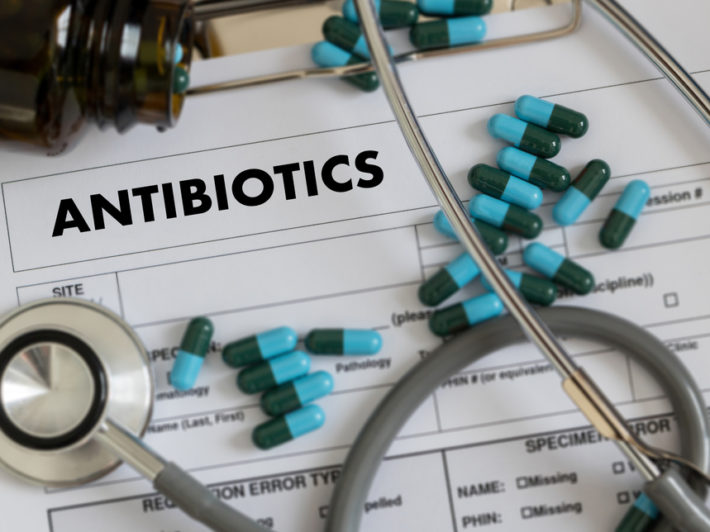
by Whitney Crouch, RDN, CLT
According to the CDC, of the 154 million prescriptions written for antibiotics each year, at least 30% are unnecessary, and the remaining 70% need to be prescribed more specifically for the infection type, including drug selection, dose, and duration.1 The goal of the CDC is to reduce the number of unnecessary antibiotic prescriptions by 50% by the year 2020.1
The discovery of antibiotics has, no doubt, saved millions of lives, but there are two sides to every coin. The CDC aims to not only reduce nationwide exposure to unnecessary antibiotics, but also to reduce the broad-spectrum use of some antibiotics used as “catch-alls” for various infection types. Why is this?
The answer lies in the impact that antibiotics have, not just on the human body, but on the bacterial microbiome that the human body is home to – the trillions of bacteria found not just in our gut, but on our skin, our airways, and in the womb of pregnant women (i.e., everywhere). Antibiotic effects are also seen in the larger ecosystem of the natural world and our food chain.
Agricultural antibiotic exposures and the gut impact
Our sensitive microbial ecosystems are not only affected by the medicine we take for illness, but by the food choices we make, the environmental exposures we have, and even our stress levels.2-3
Of all antibiotics sold in the US, approximately 80% are sold for use in animal agriculture; about 70% of these are “medically important”.4 Antibiotics are administered to animals in feed to marginally improve growth rates and to prevent infections.4 Consuming raw, undercooked, or otherwise contaminated animal products exposed to antibiotic treatment is one way for humans to be exposed to these antibiotics, and this treatment can also lead to antibiotic-resistant strains of bacteria in these animals. Produce that is sprayed with manure (used as fertilizer) that has been contaminated with antibiotics is another food-borne route of exposure. These types of exposures may cause slow, low dose exposure to antibiotics in humans that reduce the gut’s healthy bacterial diversity or cause an acute illness from bacterial contamination.4
The immune system and gut go hand-in-hand
It is well established now that much of the immune system resides in the gut. The gut microbiota exerts a myriad of beneficial functions for the host; some would say the gut microbes could even be considered an additional organ. Commensal gut bacteria are known to convert primary bile acids into secondary bile acids for dietary fat absorption, ferment otherwise indigestible plant fibers to produce short-chain fatty acids (SCFAs) that feed cells of the intestinal lining (enterocytes) and modulate immune functions, produce vitamins of the B and K groups, as well as exert secondary, extra-intestinal effects on the brain and other organs.5
Antibiotics: potential short-term effects
Short-term side-effects of antibiotic use may include nausea/vomiting, diarrhea, gas and bloating, acid reflux, anxiety/depression, and/or Candida (yeast) infection.5-6 Multiple, personalized variables mediate the impact that prescription antibiotics have on the human microbiome, including the individual’s baseline microbiome, dietary habits, type of antibiotic used, as well as the antibiotic strength and duration of use.7
A 2016 study of early life antibiotic use found a class of antibiotics called macrolides, which includes erythromycin or clarithromycin,8 to be associated with an increased risk of asthma, in addition to predisposing the recipients to antibiotic-associated weight gain in later life.9 The researchers cited that overweight and asthmatic children have distinct gut microbiota composition, and that penicillins leave a weaker mark on the microbiota than macrolides.9 Another Finnish study in 595 children found that early treatment with cephalosporins showed the strongest association with pediatric Crohn’s disease development, with boys having a higher risk of this inflammatory bowel disease (IBD) than girls.10
Another study utilizing serial stool test measurements examined the long-term gut microbiota impact of a 7-day round of oral clindamycin in 8 healthy volunteers (4 treatment; 4 control).11 Stool tests were analyzed in the test and control groups on days 0, 7 and 14, and then at 3, 6, 9, 12, 18, and 24 months after the 7-day round of antibiotics. The results of stool test analyses through 24 months post-exposure displayed a significant decrease in the collective number of Bacteroides species in the test group; this gut perturbation was not seen in the control group.11 A preclinical rodent study (mouse model) found that just one treatment with clindamycin lead to changes in the mouse gut microbiome that conferred long-standing susceptibility to C. difficile infections.12
Women who plan to take antibiotics, or who have taken antibiotics and as a result have acquired a vaginal yeast infection, may also benefit from taking a yeast-based (Saccharomyces spp.) probiotic.13 Studies show that live yeast probiotics not only help to physically displace naturally occurring, albeit pathogenic yeast (Candida albicans), but they also prevent the pathogenic yeast from adhering to the epithelial cell lining of the vagina while also conferring other anti-inflammatory characteristics.13
Antibiotics: potential long-term risks5,14-16
- Irritable bowel syndrome
- Inflammatory bowel disease (Crohn’s disease)
- Food sensitivity/intolerance
- Food and nutrient malabsorption
- Gas and bloating
- Autoimmune disease (diabetes, celiac disease, etc.)
- difficile infection
- Recurrent Candida (yeast) infection
- Asthma
- Allergies
- Overweight/obesity
- Development of antibiotic resistant bacterium
Preserving the gut microbiome via concomitant and post-antibiotic strategies
In addition to a diet low in refined carbohydrates and rich in non-starchy vegetables and fermented foods, taking prebiotics and probiotics during a course of antibiotics can be a way to stave off greater disruption to the gut microbiome.
Pairing prebiotic foods (i.e., chicory, dandelion greens, garlic, leeks, onions, white and sweet potatoes, etc.) and supplements (e.g., fructooligosaccharides [FOS]) with targeted, evidence-based gut- and immune-supporting probiotic strains (both bacterial and yeast-based, such as Saccharomyces boulardii) can help offset the antibiotic’s deleterious effects.17 A multi-strain bacterial probiotic with 25-100 billion units can be taken as tolerated during antibiotic treatment and continued into the weeks or months following antibiotic exposure.18 Saccharomyces boulardii has been shown to improve gut lining integrity by increasing secretory IgA, binding pathogenic bacteria, and other mechanisms.19 Duration of probiotic use may depend on type and duration of the antibiotic treatment
Key points:
- Liberal antibiotic prescription and use should be reined in to reduce antibiotic resistance and deleterious effects on the gut and overall health
- Eat and/or supplement with prebiotic and probiotics to support a healthy gut microbial community
- Diversify the probiotics: multi-strains, bacteria and yeast, supplements and food-based
- Higher doses of probiotics may be required to make an impact
The future? Fecal microbiota transplants, etc.
Alternative strategies, such as fecal microbiota transplants (FMTs), have been used to treat recurrent C. difficile infections, with a cure rate >90%.20 Though this may seem to be a more extreme route of treatment, it is gaining traction and becoming a standard of treatment in individuals with severe gut dysbiosis.
The future of antibiotic treatment and prescription is not clear, however targeted antibacterial treatment, prophylactic probiotics, and improved alternatives to antibiotic therapies are already being used in clinical practice. Always consult with a qualified healthcare provider regarding targeted prophylactic or post-antibiotic treatment strategies.
Citations
- CDC. CDC: 1 in 3 antibiotic prescriptions unnecessary. https://www.cdc.gov/media/releases/2016/p0503-unnecessary-prescriptions.html. Accessed October 5, 2018.
- Zijlmans MA et al. Maternal prenatal stress is associated with the infant intestinal microbiota. Psychoneuroendocrinology. 2015;53:233-245.
- Kato-Kataoka A et al. Fermented milk containing Lactobacillus casei strain Shirota preserves the diversity of the gut microbiota and relieves abdominal dysfunction in healthy medical students exposed to academic stress. Appl Environ Microbiol. 2016;82(12):3649-3658.
- Martin MJ et al. Antibiotics overuse in animal agriculture: a call to action for health care providers. Am J Public Health. 2015;105(12):2409-2410.
- Becattini S et al. Antibiotic-induced changes in the intestinal microbiota and disease. Trends Mol Med. 2016;22(6):458–478.
- Huizen J. Medical News Today. What are the side effects of antibiotics? https://www.medicalnewstoday.com/articles/322850.ph. Accessed November 9, 2018.
- Panda S et al. Short-term effect of antibiotics on human gut microbiota. PLoS One. 2014;9(4):e95476.
- Merriam-Webster. Macrolide. https://www.merriam-webster.com/medical/macrolide. Accessed October 3, 2018.
- Korpela K et al. Intestinal microbiome is related to lifetime antibiotic use in Finnish pre-school children. Nat Commun. 2016;7:10410.
- Virta L et al. Association of repeated exposure to antibiotics with the development of pediatric Crohn’s disease–a nationwide, register-based Finnish case-control study. Am J Epidemiol. 2012;175(8):775-784.
- Jernberg C et al. Long-term ecological impacts of antibiotic administration on the human intestinal microbiota. ISME J. 2007;1(1):56-66.
- Buffie CG et al. Profound alterations of intestinal microbiota following a single dose of clindamycin results in sustained susceptibility to Clostridium difficile-induced colitis. Infect immun. 2012;80:62–73.
- Pericolini E et al. Therapeutic activity of a Saccharomyces cerevisiae-based probiotic and inactivated whole yeast on vaginal candidiasis. Virulence. 2017;8(1):74-90.
- Lewis BB et al. Loss of microbiota-mediated colonization resistance to clostridium difficile infection with oral vancomycin compared with metronidazole. J Infect Dis. 2015;212(10):1656-1665.
- Langdon A et al. The effects of antibiotics on the microbiome throughout development and alternative approaches for therapeutic modulation. Genome Med. 2016;8:39.
- Mårild K et al. Antibiotic exposure and the development of coeliac disease: a nationwide case-control study. BMC Gastroenterol. 2013;13:109.
- Stier H et al. Influence of Saccharomyces boulardii CNCM I-745on the gut-associated immune system. Clin Exp Gastroenterol. 2016;9:269-279.
- Goldstein EJ et al. Pathway to prevention of nosocomial clostridium difficile infection. Clin Infect Dis. 2015;60 Suppl 2:S148-58.
- Kelesidis T et al. Efficacy and safety of the probiotic Saccharomyces boulardii for the prevention and therapy of gastrointestinal disorders. Therap Adv Gastroenterol. 2012;5(2):111-125.
- Bakken JS et al. Treating Clostridium difficile infection with fecal microbiota transplantation. Clin Gastroenterol Hepatol. 2011;9(12):1044-1049.
Whitney Crouch, RDN, CLT
Whitney Crouch is a Registered Dietitian who received her undergraduate degree in Clinical Nutrition from the University of California, Davis. She has over 10 years of experience across multiple areas of dietetics, specializing in integrative and functional nutrition and low toxicity living. When she’s not writing about nutrition or educating others on non-toxic skincare and hygiene, she’s spending time with her husband and young son. She’s often found running around the bay near her home with the family’s dog or in the kitchen cooking up new ideas to help her picky eater expand his palate.





Outstanding!